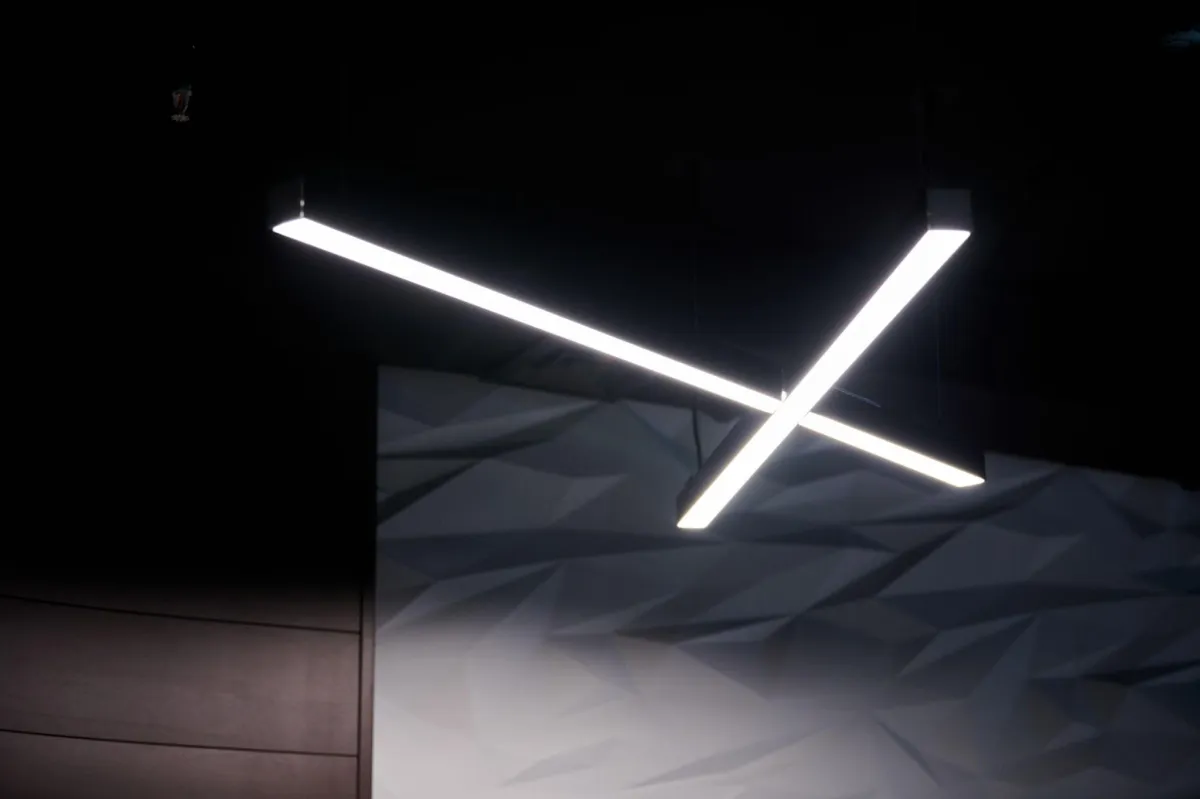A Guide for Commercial Renovation
The Impact of Lighting Design on Commercial Renovations and Employee Productivity
Lighting is an often-overlooked aspect of commercial renovations, but its impact on both the aesthetics of a space and employee productivity is profound. At TAS Design, we believe that great design is about more than just appearance; it’s about creating spaces that function optimally for the people who work within them. Whether you’re renovating an office, a retail space, or another commercial environment, thoughtful lighting design can improve employee well-being, increase efficiency, and enhance the overall success of your business. In this article, we’ll explore how proper lighting design can influence commercial renovations and directly affect productivity.

Lighting Design and Its Role in Commercial Spaces
Lighting design is more than just choosing fixtures or deciding where to place them. It involves understanding the way light interacts with space and how it can influence mood, energy levels, and even physical health. Poor lighting in a commercial environment can lead to issues like eye strain, headaches, and decreased focus, which, in turn, lower employee productivity.
Understanding the Basics of Lighting Design
Before diving into the specific effects of lighting on productivity, it’s essential to understand the core components of lighting design in commercial renovations. There are three primary types of lighting to consider:
Ambient Lighting: This is the general lighting in a space that provides overall illumination. It is often created by ceiling fixtures or recessed lighting and is essential for visibility and safety.
Task Lighting: Task lighting focuses on specific areas where detailed work is carried out. Desk lamps, under-cabinet lights, and adjustable track lighting fall under this category. It’s crucial for reducing eye strain during tasks that require precision.
Accent Lighting: Used to highlight architectural features or decorative elements, accent lighting adds depth and character to a commercial space. While it doesn’t directly impact productivity, it plays a role in creating an inviting and aesthetically pleasing environment.
Each of these types of lighting serves a unique purpose and, when used together, can create a balanced and efficient workspace. Focusing solely on aesthetics or under-lighting an office can lead to a dull or uninspiring work environment, which in turn affects productivity.
The Importance of Natural Light in Renovations
Natural light has the most significant impact on employee health and productivity. Numerous studies have shown that exposure to natural light improves mood, energy levels, and cognitive function. Incorporating large windows, skylights, and glass partitions in commercial renovations allows natural light to flood into workspaces. This simple design choice can lead to a significant increase in employee satisfaction and output.
Renovating older commercial spaces often involves replacing or enlarging windows to optimize the amount of natural light. However, achieving the right balance between natural and artificial lighting is crucial, especially when there are seasonal shifts in daylight or when the space doesn’t have easy access to exterior windows.
How Lighting Design Affects Employee Productivity
The link between lighting and employee productivity is well-established. Appropriate lighting makes it easier for employees to concentrate on their work, reduces errors, and boosts overall job satisfaction. On the other hand, poor lighting can lead to fatigue, frustration, and even health problems, all of which diminish productivity.

Optimizing Task Lighting for Maximum Efficiency
In most commercial spaces, task lighting is directly tied to the type of work being performed. For example, an office filled with cubicles may require adjustable desk lamps, while a retail environment might need focused lighting for sales displays or workstations. It’s essential that lighting designers consider the specific needs of each employee or team when planning a renovation.
For work that involves significant screen time, lighting should be soft and diffused to reduce glare on monitors. Adjustable task lights also allow employees to personalize their workspace, providing the right amount of light for their needs without disturbing colleagues.

Impact of Color Temperature on Focus and Mood
One aspect of lighting that has a considerable influence on productivity is color temperature, measured in Kelvin (K). Lighting with a lower color temperature (around 2700K to 3000K) is warmer and more yellow, often used in hospitality settings for a relaxed atmosphere. On the other hand, higher color temperature lighting (4000K to 6000K) is cooler and mimics daylight, which is ideal for work environments.
Cool white light, typically used in offices, is associated with higher levels of alertness and productivity. It helps keep employees focused and reduces feelings of fatigue. Implementing lighting solutions with variable color temperature allows businesses to adjust the atmosphere based on time of day or the task at hand.

Circadian Lighting and Employee Health
Circadian lighting, which mimics the natural progression of daylight, is becoming increasingly popular in modern office designs. This type of lighting supports the body’s internal clock, helping employees feel more alert during the day and promoting better sleep at night.
By adjusting the color temperature and intensity of light throughout the day, circadian lighting systems can enhance employee productivity. Morning light can be bright and cool to energize staff, while afternoon lighting can be slightly warmer, promoting relaxation as the day progresses. The benefits of circadian lighting include improved cognitive function, enhanced mood, and increased overall productivity.
Commercial Renovations and Energy Efficiency
Aside from employee productivity, commercial renovations involving lighting design can lead to significant energy savings. Modern lighting technologies, such as LEDs and smart lighting systems, are not only more energy-efficient but also provide greater flexibility and control.

Energy-Efficient Lighting Solutions
When planning a renovation, choosing energy-efficient lighting solutions can help reduce operational costs. LEDs, for instance, consume less electricity than traditional incandescent or fluorescent lights and have a longer lifespan. Additionally, smart lighting systems, which use sensors and automation, ensure that lights are only used when needed, minimizing unnecessary energy consumption.

Sustainable Lighting Design for a Greener Future
Sustainability is increasingly becoming a priority for businesses undergoing renovations. Incorporating eco-friendly lighting design—such as using daylight harvesting sensors or solar-powered lighting systems—not only reduces a building’s carbon footprint but also enhances its reputation among clients and customers who value green initiatives.
Practical Tips for Incorporating Effective Lighting in Commercial Renovations
Now that we’ve explored the key ways lighting impacts productivity, let’s discuss some practical strategies for incorporating effective lighting design in your next commercial renovation project.

Conduct a Lighting Audit
Before beginning a renovation, conduct a thorough lighting audit of your current space. Assess where natural light enters, identify areas with inadequate lighting, and note any energy inefficiencies. This will help in designing a new lighting system that addresses the specific needs of your space.

Collaborate with Lighting Experts
Engaging a lighting designer or working with a full-service architectural firm like TAS Design ensures that your lighting plan is both functional and aesthetically pleasing. Professionals can help you choose the right fixtures, optimize the placement of lights, and ensure compliance with energy codes and standards.

Prioritize Employee Comfort
Always keep the comfort and health of your employees in mind when designing a lighting system. Incorporate adjustable task lighting, optimize natural light, and ensure that artificial lighting is properly diffused to minimize glare and eye strain. By doing so, you create a workspace that encourages focus and reduces fatigue.
Conclusion
In the realm of commercial renovations, lighting design is a powerful tool that can significantly impact employee productivity, well-being, and the overall success of a business. Thoughtful integration of natural light, the strategic use of task and ambient lighting, and the incorporation of energy-efficient solutions all contribute to creating a workspace that fosters efficiency and comfort.
TAS Design understands the critical role lighting plays in commercial spaces, and we are dedicated to crafting designs that enhance both the aesthetic and functional aspects of a business. Whether you’re planning a complete renovation or a small office upgrade, prioritizing lighting design will help ensure a successful and productive environment for years to come.
Contact Us
Office Hours
Social Media
Mon- Fri 8 am - 5 pm
Sat, Sun- Closed except by appointment





Contact Us
1 540-302-2593
2507 Bluff Road
Roanoke VA 24014
Office Hours
Mon- Fri 8 am - 5 pm
Sat, Sun- Closed except by appointment











